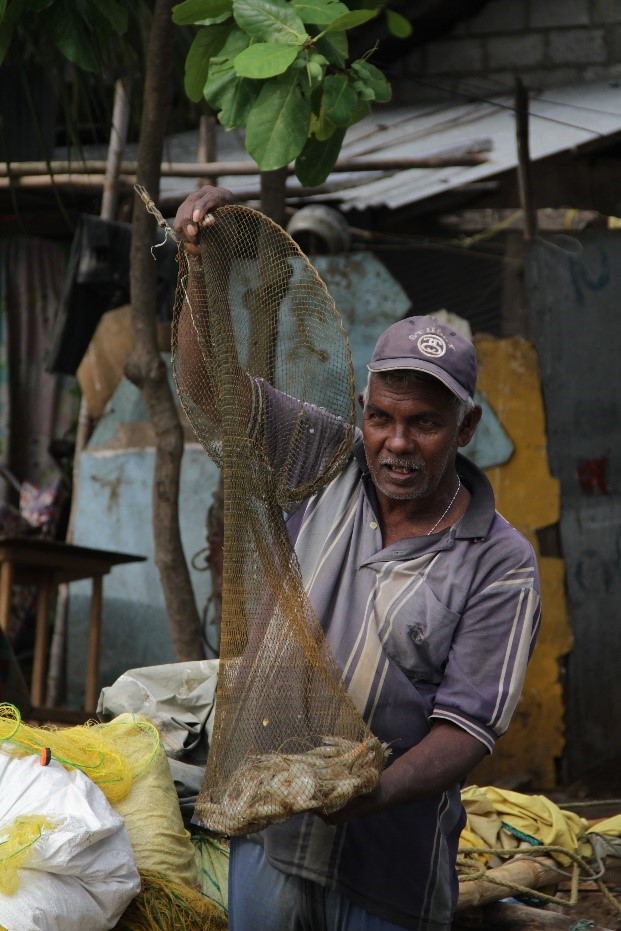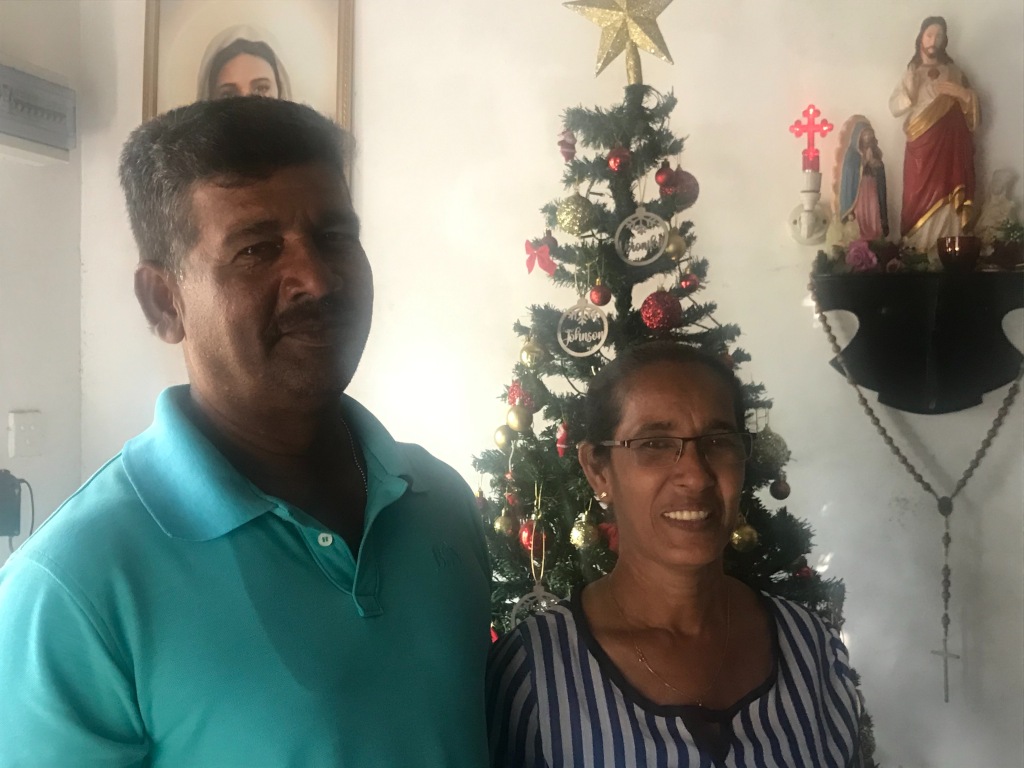Negombo is situated on the west coast of Sri Lanka, around 38 kms north of Colombo and 9 kms to the Bandaranaike International Airport in Katunayake. The city is best known for its long sandy beaches and its century old fishing industry. A majority of the bilingual community living around the lagoon is linked to the fishing industry.
At the mouth of the lagoon there are two interlinked inlands surrounded by brackish water known as Munnakaraya. Generations back fisherman in Munnakkaraya lived in small thatch-roofed houses in shanties. Today they have developed vastly with the thriving fishing trade and support received from relatives who have migrated to Italy. Areas that have developed with the influence from these migrants is known as ‘Little Italy’. Here, you find families living in two-storied houses decked with decorative roofs, tiled flooring and luxury furnishing. Driving along the Munnakaraya Road you across the St Nicholas Church, where the fisherman say they go to offer their prayers to the Saints before they leave on a long fishing trip.
Fisherman in Munnakkaraya follow traditional fishing methods that has been passed down for generations. They rely on traditional knowledge of the seasons and use outrigger canoes carved out of tree trunks and nylon nets to bring in modest catches. There are two types of traditional boats – one is called Oruva, a sailing canoe and the other a paruva, a large, man-powered catamaran fitted with kurlon dividers. Most are small day boats that come back the same day, with many of them offloading their catch along Negombo’s large beach front. During the spawning season the fishermen will go out to sea early in the morning and come back with a catch of small fish like salaya, keeramin, sudaya, sura para, hurulla, handello and halmassa. Unlike prawns and crabs, these fetch very low prices. The left over fish is taken home. Like the ebb and flow of the waves on the beach, fisherman and their families know how to tide over lean times by borrowing money from lenders.
By crack of dawn the lellama or fish market is buzzing with activity as hundreds of boats dock bringing their catch after venturing weeks into the deep seas. The larger boats tend to spend at least a couple of weeks out fishing and it was these boats that had the larger hauls. They are motor powered fishing trawlers owned by rich fish mudalalis or traders. Fishing is constant grueling work. Most men start when they are young and go on till they are 70 years of age. Due to problems that are both personal as well as a result of the issues in
the industry they are working they hardly save any money. Only a few fisherman are lucky to reach the level of success enjoyed by the fish mudalalis. Most fishermen work in fishing boats are allowed a percentage of the revenue brought in by the haul.
Fish in large qualities is traded by the fish mudalalis at the big market nearby Lorries of frozen fish arrive here from Mannar, Trincomalee and the south. The best catch from the boats arriving at the fishing harbor, like yellow fin tuna, are traded off in mid seas, for export. “The best of the catch never reaches this market” confirms a fisherman leading us inside. After the fish is valued and priced, they are loaded into ice packed cartons and transported to other areas of the country. “The fish that gets thrown out is turned into dry fish” he explains pointing to the long lines of women working under the harsh sun.
We walk up to take a closer look the women working on the dry fish lines, their hands were still busy like machines cutting, cleaning fish and throwing the fish from one basket to another. Two women lift the heavy basket and take it to the shore line, they let waves bump it to-and fro – presumably washing the fish. They claim the salt water is good to clean the fish.
Further down women tend the fish that is already dried on one side, flipping the pieces. These women work 5-8 hours starting at the crack of dawn. The reason why they are so fast in what they do is because of the harsh Sun pelting down on them, making it impossible to work beyond 2 pm. Yet the women don’t look tired –they are cheery and talkative.
We move down to a place where women are rubbing salt on large fish sliced lengthwise – a balaya. The fish is stacked into cartons dripping with salt. They set in 3 to 5 days, after which they can be dried on the beach like the rest of the fish. From shark to balaya, linna to halmasso, fish in every size is being processed on this line. In the evening everything is covered in thick plastic sheets and kept dry.
Making dry fish is one method of preservation – the other traditional preparation is ‘malu jaadi’. Jaadi is fairly less know compared to dry fish, and its taste also very different.
Having arrived at the lellama early in the morning to buy some fresh fish, we were introduced to Anthony Figurado (54) who has been a fisherman for the past 35 years. We then drove past the lellama, down a narrow road to locate his house in the village of Munnakkaraya. His wife Yogaraja (51) greets us and introduces us to her mother and sister. She welcomes us into her modest home and says her husband is on his way with the fish we had selected earlier in the day.
Part of this fish will be for the preparation of ‘malu jaadi’. Apart from selecting good, fresh fish, the ingredients for Jaadi is simple – salt and goraka (Garcinia), the balance of both gives the fish a unique taste, a dash of turmeric and some karapincha (curry leaves) and rampe (pandan leaves).This fish is layered with salt and goraka. “You can have many layers as you want, but the fish must be covered in salt” she explained as she made the preparation.
The pot is closed tightly with a lid and covered with a clean cloth and tied around with a piece of string. The common saying “jaadiyata mudiya” stems from the requirement of a tightly fitting lid for a pot of jaadi and is used in colloquial language to refer to 2 people who are well-matched. The pot will be kept in a cool place for about a week. When you open it you will find that the fish has slightly shrunk and become hard. At the bottom will be a liquid – it’s the moisture from the fish drawn by the concentration of salt in the mixture. The liquid is called “lunijja” and is used to enhance the taste in other dishes like billing curry and pol malung. Once prepared ‘maalu jaadi’ can be kept for a long time.
The fisherman’s wife said that the jaadi can be prepared as a white curry with a lot of coconut milk – onions, garlic and tomatoes.
We asked Anthony if the fisherman were facing any challenges. He said “the fisherman in the western coast have been complaining for years about the reduction in fish stocks”. According to these fisherman, most of the fish breeding areas in Negombo have been affected and the fishing community is facing a bleak future. They point to large scale development projects such as the Negombo highway in 2009, and Port City in 2014 that were constructed overlooking serious environmental impacts to the breeding grounds. Local fisherman who catch prawns in the lagoon said their harvest dropped drastically due to the vibration of vehicle movement on Colombo-Katunayaka highway. Further the construction of the highway 15 years ago, damaged and reduced the extent of mangroves that serve as breading grounds for prawns and fish. Even before it could bring in any revenue the Colombo Ports City development project has cause severe damages to the sea bed, changing the bio diversity, reducing the green cover and shifting the tides on the western coast of Sri Lanka. A country that has been ignoring environment damages made another big mistake by allowing the X-Press Pearl, the ship that was refused birthing in other ports to come into Sri Lanka territory where it sunk in the western coast in June 2021, spilling 25 tonnes of nitric acid, along with other chemicals and cosmetics into the seas. This exacerbated already damaged breading grounds leading to a drastic drop in fish hauls towards the latter part of 2021. Both, traditional small boats and bigger multi-day trawlers are complaining of reduced fish stock.
Some say environmental changes, unprecedented climatic variations and illegal fishing is threatening the livelihood of local fishermen. Since the catch is reducing, the boats are venturing further into the sea. “Sometimes we go beyond the border, into international water. Here you have to compete with other fishing boats, from Israel, America and India who are better equipped than us” explained the fisherman. “We would be lucky to catch a good haul of yellow fin tuna before the foreign boats arrive. We communicate with each other and help local fisherman arrive to the best spots. One good catch and we have made enough money for weeks” he adds. This is the only way small boats can compete with larger fishing trawlers.
Another reality we face is that the youth of fisher families do not find the fishing profession attractive and prefer alternative employment. According to recent reports, the total fishing population in the Negombo Fishing District is 33,604 and only 9,249 of them are active fishermen. The report states that approximately 79.9 percent of these active fishermen are above the age of 40 and fishermen between the ages of 20 and 29 years are only a mere 1.5 percent. There are many reasons for it and primary amongst them is a lack of upward mobility. This is the reason why many of the youth in that area are finding ways to migrate to Australia and Italy, most of them using illegal methods and crossing the vast ocean in small crafts.
Anthony has two daughters. Usually only the male children in a fisher family takes after their father’s trade. His eldest daughter is married and has given birth to twins. Her husband is living and working in Italy. He manages to visit the family twice a year. Anthony is still paying the loan he has taken for his daughter’s wedding. A wedding is a big celebration in Negombo and he shows us the wedding pictures proudly. “Many of us, fisherman, have loans to pay. I want to pay off all my debts before I retire from the fishing trade”.
We ended our conversation on “malu jaadi”. When there is excess amount of fish, the fisher families use this traditional preparation to preserve the stock. As in other fishing communities jaadi making is fading away, there is no longer a need – traders are able to freeze the stock. Soup and fish explain half the emotions. In Negombo people are always enjoying a good meal with one or two types of fish cooked tastefully. Anthony and Yogaraja surprised us with a hastily prepared meal for lunch. Yogaraja led us into their modest living room where we sat down to enjoy a simple meal of rice and curry. Everything was wonderful – the highlight of the day was an amazing jaadi white curry prepared by Yogaraja’s mother. She seemed to be a seasoned cook. Her face lit up with joy as we shared our appreciation of this rare dish. It would be a pity should this traditional method be forgotten with the current modern trends.
Cooking Tales
This article is a part of a series that illustrates pluralism through diversity of cultures in Sri Lanka. The author wishes to thank and acknowledge support received from Internews through a fellowship grant. All rights reserved by Internews @2022.






